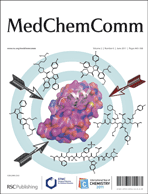We are delighted to announce a special themed issue of MedChemComm on Natural Products, due for publication in summer 2012
This themed issue, guest edited by Professor Christopher T. Walsh and Dr Sylvie Garneau-Tsodikova will collect together in one place some of the latest exciting research natural products chemistry, including, but not limited to: biosynthesis, novel natural products as drug or drug leads, novel technologies for natural products discovery, novel chemical transformations in natural product biosynthesis, as well as chemical and chemoenzymatic synthesis of natural products. Authors will benefit from increased exposure of their research alongside similar high level and cutting edge work.
Deadline for Submission: January 31, 2012. Although publication of the issue is scheduled for summer 2012, web publication of the Advance Article versions of each manuscript will proceed as soon as the article is ready, ensuring that research is disseminated without delay.
Manuscripts can be submitted using the online web submissions service at http://mc.manuscriptcentral.com/mcc. Please indicate on submission in the comments to editor section that your manuscript is invited and intended for the Natural Products themed issue.
For more information please contact the Editorial Office.











 The p53 signalling pathway is responsible for regulating the cell cycle, initiating DNA repair and triggering apoptosis where necessary. Its crucial importance can clearly be seen by the fact that about half of human cancers contain alterations in the p53 pathway. The proteins MDM2 and MDMX (a.k.a. MDM4) negatively regulate p53, and altered levels of these proteins are often deemed responsible for p53 alterations. As a result MDM2 has been extensively studied, but few MDM2 inhibitors have made it as far as clinical trials.
The p53 signalling pathway is responsible for regulating the cell cycle, initiating DNA repair and triggering apoptosis where necessary. Its crucial importance can clearly be seen by the fact that about half of human cancers contain alterations in the p53 pathway. The proteins MDM2 and MDMX (a.k.a. MDM4) negatively regulate p53, and altered levels of these proteins are often deemed responsible for p53 alterations. As a result MDM2 has been extensively studied, but few MDM2 inhibitors have made it as far as clinical trials.